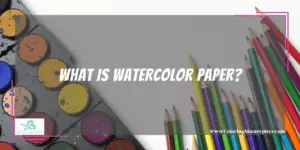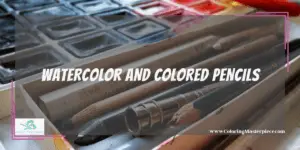Colored pencils are one of the most common and easy-to-use drawing mediums. I love them because they are excellent for layering, blending, shading, and detail work with various other mediums and types of paper. With all of the paper options available to you, you might be wondering if watercolor paper is an ideal type to use with colored pencils.
Watercolor paper is an excellent surface for both dry and water-soluble colored pencils because it is durable and has a significant texture for layering and blending. Keep in mind that the paper’s texture will influence the final product and be visible through your artwork.
When colored pencils are applied to heavily textured paper, the texture becomes partially visible, which creates a visually exciting piece, but a textured rather than smooth finish. Several factors influence this, which are described below.
What is Watercolor Paper?

Paper comes in a range of thicknesses, also called “weight.” It also comes in different textures to suit different mediums and create different finishes. Watercolor paper is a thick (or “heavy”) variety of paper designed to be absorbent to keep wet watercolors from running or ruining the surface. Some watercolor paper varieties contain cotton fibers, which minimize warping or wrinkling when exposed to substantial amounts of water. The watercolor paper also has a substantial “tooth,” which means the surface has a significant amount of texture. This helps with absorption and helps keep the watercolor from running on the surface.
Watercolor paper can be bought individually or in pads, sketchbooks, boards, or even rolls. It comes in nearly limitless sizes, though 9 in. x 12 in. pads are perhaps the most common.
Is Watercolor Paper Good for Colored Pencils?
Watercolor paper is excellent for colored pencil artwork. The durability of watercolor paper makes it an excellent medium for standing up to the layering, blending, and occasional erasing that goes along with using colored pencils. However, there are a few things you may want to consider before choosing it for your project.
Tooth
“Tooth” refers to the texture on the surface of the paper. Having a medium to high tooth is essential for working with colored pencils because the texture helps the colored pencil grip the surface and apply generously and evenly.
Watercolor paper can vary in texture. The cold-pressed paper has a high tooth, which means the surface is quite rough compared to smoother papers like sketch paper or printer paper. This means that more pencils will transfer to the paper with minimal pressure, creating a more excellent range of tones and making it easier to lay down thick layers of color.
This can be a highly desirable quality in certain pieces but be aware that the textured quality of watercolor paper will show through your finished artwork. It will also take more layers of colored pencil to fill in the tiny white gaps in the surface and create intense color.
If you desire a smoother finish and more effortless blending, reach for a smoother-textured hot-pressed watercolor paper. This type of paper is less absorbent when working with wet mediums but creates a less textured finish with dry mediums like colored pencils. It also has a more rigid surface to stand up to repeated pencil strokes.
Weight
Generally speaking, watercolor paper is a heavyweight, which means it is quite thick. A heavier weight of paper helps it withstand the pressure and rubbing of colored pencils. The heavier weight can also create a very desirable and quality finished product if you intend to sell or frame your finished artwork. Watercolor paper can vary in weight, with 140 lb. and 300 lb. being the most common. Using a dry medium like colored pencils means that a more massive paperweight isn’t strictly necessary unless you would like a stiffer finished product. If not, you may want to reach for a lighter type of paper like the 140 lb., which is generally less expensive as well.
Price
Watercolor paper is typically more expensive than other varieties of sketching or drawing paper. The paper takes more material and higher quality materials to manufacture, which costs more money. Pads of watercolor paper will also come with fewer sheets than similar-sized pads of other types. If affordability is a consideration for you as an artist, thinner varieties of paper like drawing or sketch paper will have more sheets per pad at a lower cost. These can produce great finishes but will not be as stiff and will have less texture. The less expensive paper may also be less durable over time.
Color
Because watercolors are a transparent medium, most watercolor paper is white or off-white to allow the color to show up. However, tinted and toned varieties exist, including a range of colors, grey and even black. These can create exciting effects for colored pencil drawings. The opaque nature of most colored pencils means they will show up on most colors of paper. If you’re looking for toned paper, drawing and sketch paper might be easier to find and less expensive. If desired, you can also create your washes with watercolor on white or cream paper for a custom tint.
Watercolor and Colored Pencils

If you’re using watercolor pencils or combining colored pencils with traditional watercolors, you’ll want to choose watercolor paper.
Watercolor Pencils
Water-soluble or “watercolor” pencils combine the styles and techniques of watercolor paints and colored pencils. Regular colored pencils have a wax or oil-based, while watercolor pencils have a water-soluble base. Watercolor pencils will run and bleed when exposed to water, creating watercolor paint. This enables the artist to create beautiful washes or fine details with the same medium. For watercolor pencils, watercolor paper is not only okay but recommended, as the watercolor paper is designed to stand up to water exposure. Watercolor pencils can be applied to the paper, and then activated with a wet brush, intensifying color. You can also use a wet brush to blend two colors layered together, touch a wet brush directly to the pencil to pick up pigment, and then apply it to the paper. Using regular drawing paper or sketch paper for watercolor pencils is okay if you’re only using them dry. Still, if you want to activate the colored pencil with water, these papers will wrinkle or buckle.
Mixed Media
Layering colored pencils over dried watercolors can help enhance a watercolor painting with additional detail work, texture, richer colors, or blending. Watercolors are a transparent medium, which means you can see through them quite quickly, and it can take many layers—with drying time in between each—to build up enough pigment to get deep colors. Colored pencils, however, are more opaque, making building color easier. This can deepen shadows and colors, as well as create visual interest when layering different colors. The opaque quality of colored pencils also helps with highlighting or lightening areas of a watercolor painting. Watercolors are a difficult medium to lighten the color with, especially once dry. Colored pencils, however, can be layered on top to create a lighter color if too much color has been applied, or white can be used to create subtle to strong highlights.
On the flip side, starting with a watercolor wash can also create a smooth base of color for your colored pencil drawings. You can also use watercolor to help you block in larger areas of color, quickly filling in a highly textured paper’s gaps. Just make sure your watercolor is completely dry before introducing the colored pencil! Scratching at the wet paper’s surface with a pencil can damage the surface and ruin your hard work. Drying time can vary based on paper type, humidity, temperature, and how much water was applied initially. Be sure to wait at least a few minutes and, after a visual inspection, check that it is dry to the touch (and not cool, which indicates it is still moist). Some artists use a hairdryer to speed up the process, but make sure the watercolor is well absorbed into the paper first. Otherwise, you might push your paint around.
Interested in watercolor brush pens? Check out our article here to find out all about them!
Frequently Asked Questions
What other papers are suitable for a colored pencil?
Colored pencils can be used on virtually any paper, but papers with a medium tooth create an excellent middle ground for smooth application and texture. Drawing paper, sketch paper, and colored pencil paper all have great surfaces for blending and layering. Experiment with different textures!
What are artist-grade and student-grade colored pencils, and which should I choose?
Artist-grade colored pencils are of higher quality, typically containing better pigments, better durability, smoother application, and longer-lasting effects. Student-grade colored pencils are usually harder and contain fewer pigments but are more affordable. If you care about quality and longevity, reach for artist-grade. If the price is a concern, student grades can create great art but may not be as deep or bright.
Interested in learning more? Click here to download my free adult coloring eBook and sign up for my email newsletter!
Disclaimer: The information provided by ColoringMasterpiece.com (“The Site”) is for general informational purposes only. All information on the Site is provided in good faith, however, we make no representation or warranty of any kind, express or implied, regarding the accuracy, adequacy, validity, reliability, availability, or completeness of any information on the Site. Under no circumstance shall we have any liability to you for any loss or damage of any kind incurred as a result of the use of the Site or Reliance on any information provided on the Site. Your use of the Site and your reliance on any information on the Site is solely at your own risk. This blog post is for educational purposes only and does not constitute legal advice. Please consult a legal expert to address your specific needs.
Terms and Conditions: https://coloringmasterpiece.com/terms-and-conditions/
